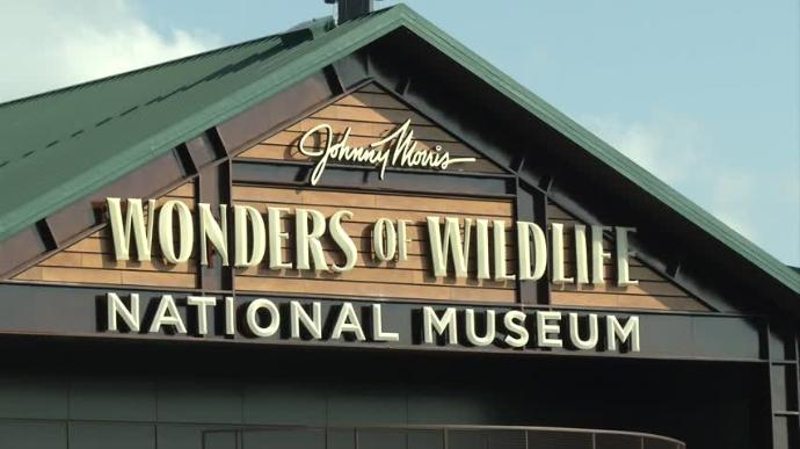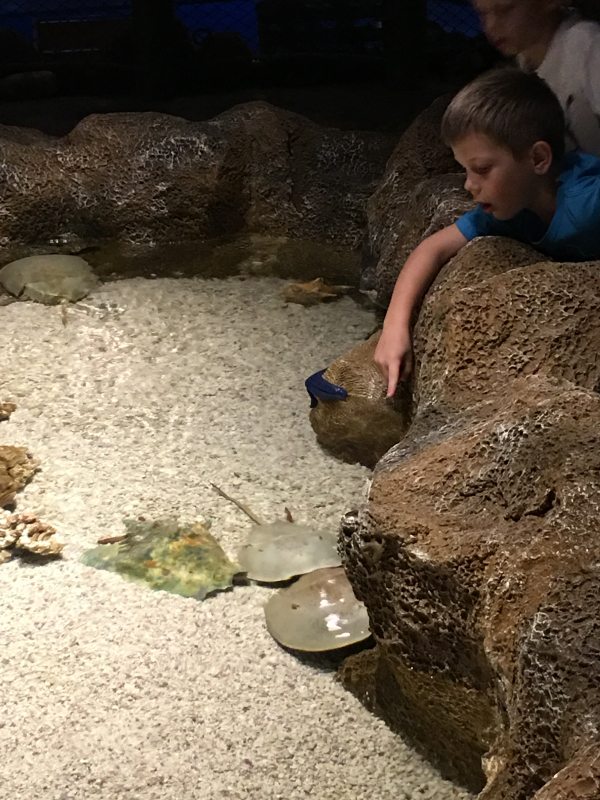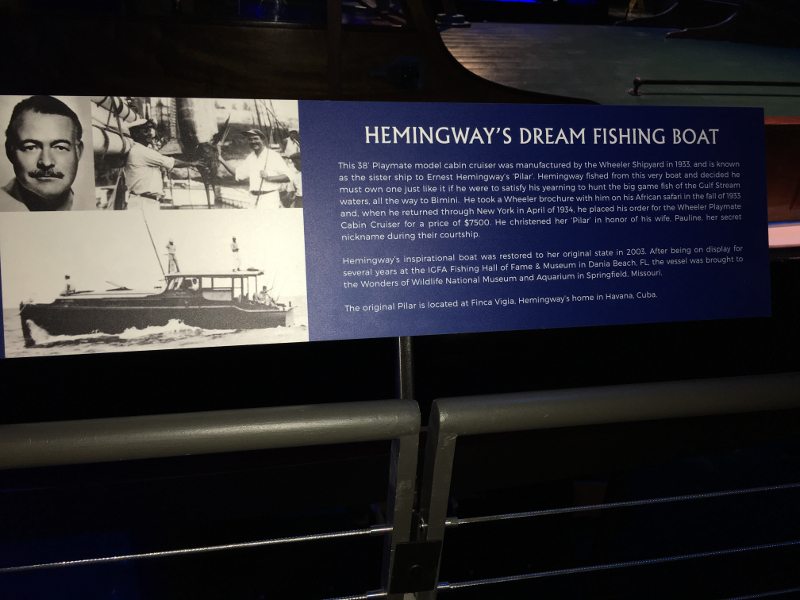
Ten years and untold millions of dollars in the making, the Wonders of Wildlife National Museum & Aquarium opens its doors to the public on Friday, September 22.
Located on the same property as the Bass Pro Shops National Headquarters in Springfield, Missouri, the Wonders of Wildlife museum originally opened in 2001. In 2007, the struggling attraction closed for renovation after being purchased outright by Bass Pro founder and CEO Johnny Morris. The facility has remained closed for the past decade as the museum has expanded to more than four times the original footprint. After years of rumors of potential opening dates, patrons are finally able to visit the museum and aquarium and see Morris’ dream of conservation history, education, and advocacy realized.
If nothing else, the newly (and in some cases, still being) renovated Wonders of Wildlife is an impressive facility. At over 350,000 square feet, Wonders of Wildlife is larger than the Smithsonian Museum of Natural History. More than 1.5 miles of trails wind through the facility, which serves as home to more than 35,000 live fish, mammals, reptiles, amphibians, and birds representing between 800 to 1,000 different species. The aquarium boasts more than 1.5 million gallons of freshwater and saltwater habitats. The result is a stunning facility that is the collaboration of more than 40 leading wildlife conservation agencies and more than 2,000 painters, sculptors, woodworkers, ironworkers, taxidermists, illustrators, designers, engineers, and biologists.

Grand Opening festivities began on Wednesday, September 20, with a ribbon-cutting featuring appearances by conservation leaders from across the nation, former Presidents Jimmy Carter and George W. Bush (with a filmed segment by George H.W. and Barbara Bush), racing and outdoors sports professionals, U.S. Secretary of Interior Ryan Zinke, actors Mark Wahlberg and Kevin Costner, and music by country artists Costner, Luke Bryan, Dierks Bentley, John Anderson, and more.
GeekDad was invited to participate in Media Day activities during the days leading up to the Grand Opening. Below are the highlights of my tour.
My tour began at the Wonders of Wildlife entrance inside of the Bass Pro retail store. Visitors can explore a small museum chronicling Morris family history, the early days of Bass Pro–complete with a recreated storefront from the Brown Derby liquor store where Bass Pro began–and various motorsport sponsorships that Bass Pro has been a part of over the years. This small, personal and corporate history area is free to the public.

Admission to the rest of the museum requires payment. There are a number of options available to guests, from single ticket purchases to either the wildlife galleries or the aquarium, combo ticket purchases to both sides of the museum, as well as individual and family annual membership packages. All general admission tickets require guests to schedule the time of their visit, which favors online ticket purchases over walk-up purchases.
In order to make somewhat valid pricing comparisons, I’ll examine the individual plans. Children under four years old are free to both the wildlife galleries and the aquarium, so that makes visiting either one or both a great value for families with younger children, as they are only paying the adult ticket price to enter. Tickets for children aged 4 to 11 years old are $9.95 for the wildlife galleries, $19.95 for the aquarium, or $23.95 for a combo ticket. Adult tickets (ages 12 to 64 years old) are $14.95 for the wildlife galleries, $29.95 for the aquarium, or $39.95 for a combo ticket. Adults aged 65 and older receive 10% off of the regular adult ticket prices.
Since Wonders of Wildlife has cited the Smithsonian Museum of Natural History as a point of comparison in their press packets, that seems a fair place to compare ticket prices. Parking at the Smithsonian is $15, whereas parking is free at Wonders of Wildlife. However, entrance to the Smithsonian is free. So, for a single adult wishing to visit either the Smithsonian or Wonders of Wildlife, the cost to enter either is essentially the same. Go with more than one person over the age of three and the cost to enter the wildlife galleries at Wonders of Wildlife adds up in a hurry. For a family of four that arrives in one vehicle, the cost to park and enter the Smithsonian is still a flat $15, where you’re looking at essentially double that cost just for the adults to enter the Wonders of Wildlife galleries, plus any additional child’s ticket cost.
Looking at the aquarium ticket prices, we have a couple of relevant data points. Children can enter the Wonders of Wildlife aquarium for free until they turn four years old, which beats both the SeaLife Aquarium in Kansas City, Missouri and the Shedd Aquarium in Chicago, Illinois by a year, as they both start charging admission on three-year-olds. Children’s ticket prices, in ascending order, are $16 plus tax at the SeaLife Aquarium (though they can be purchased beginning at $12 online), $19.95 for the Wonders of Wildlife Aquarium, and $29.95 for the Shedd Aquarium (if purchased online… walk-ups pay an additional $15 per ticket at the Shedd Aquarium). Adult ticket prices compare at $20 plus tax at the SeaLife Aquarium (or starting at $15 if purchased online), $29.95 at the Wonders of Wildlife aquarium, and $39.95 at the Shedd Aquarium (again, if purchased online, otherwise you’ll pony up an additional $15 per ticket at the door).

Can I tell you whether Wonders of Wildlife is “worth the cost”? No. It’s up to you to evaluate the ticket prices for your family and weigh it against the perceived value you believe you’ll take from the experience. For those considering a visit, I recommend a combo ticket and seeing the entire museum on your first visit, then determining whether or not future visits warrant experiencing just one side of the building or seeing the entire museum and aquarium again. For those who determine after their visit that they would like to return multiple times in the next year, the cost of a single-visit ticket can be applied to an annual pass.
The wildlife galleries feature a look at wildlife management and conservation throughout America’s past. Guests begin with an exhibit of Native American and First Nation artifacts and replicas that focus on the role that conservation played in the lives of the people. Emphasis is placed on the depletion of the wild buffalo numbers due to poor wildlife management and westward expansion across the American plains. From there, guests enter a replica cabin named after former President Theodore Roosevelt, which houses artifacts and replicas from that time, when the idea of conservation and resource management became a topic of national politics. Included in the tour is an exhibit of The Boone and Crockett Club’s National Collection of Heads and Horns, founded by former President Roosevelt, featuring the mounted remains of more than 40 significant North American game animals, which debuted at New York’s Bronx Zoo in 1908.

Stepping beyond the Roosevelt Cabin are 100 paintings by artist Charles Fritz detailing the Lewis and Clark expedition. Fritz completed the collection shortly after the bicentennial of the 1803 to 1806 expedition, during which time artist traveled to sites visited on the expedition during the same seasons of the year that Lewis and Clark would have visited them, in order to best recreate on canvas what the explorers might have witnessed. In addition to Fritz’s paintings, the wildlife galleries host artwork by John Banovich and the photography of David Yarrow.
The largest and most dramatic section of the wildlife galleries are the displays of mounted animals throughout. Guests can view animals native to America’s National Parks, Africa, the polar regions, and more. The purpose of these exhibits is to bring the guests face-to-face with mounted versions of these creatures in replicas of their natural environments, for the purpose of reconnecting people with the natural world and educating them on the importance of wildlife, water, and land conservation and management. The message is shared with a mix of low-tech media, such as signs and displays, as well as more advanced technology including video boards, lighting, and climate control. For example, the lighting in the Sheep Mountain display is on a seven-minute cycle from daylight to nighttime, while the ambient temperature is lowered in the polar exhibits and increased in The Great African Hall.

From the wildlife galleries, guests can enter the aquarium. Here, guests can find exhibits honoring famous, avid, and well-known fishermen like Ernest Hemingway, Zane Grey, and a number of former American presidents, along with The International Game Fish Association’s Hall of Fame and the Bass Fishing Hall of Fame. Central to the aquarium experience is the circular 300,000 gallon Great Oceans Hall that dominates the entry lobby and the three-story bait ball, where a pair black tipped sharks keep thousands of herrings swirling in a column, mimicking their natural schooling behavior.
It’s not just the open ocean on display. Throughout the aquarium, guests will see replicas of natural and shipwrecked reefs, walk underneath a replica of a North American river, visit an Amazon-like habitat, explore replica caves featuring live bats, find displays of shells and crustaceans from across the globe, and wind through a swamp habitat that includes live fish, reptiles, amphibians, owls, otters playing in their enclosure, beavers, and a pair of black bears in both their indoor and outdoor habitats.

As for amenities, all of the bathrooms I found were large, non-gender specific, private rooms with access to baby changing equipment. The aisles are wide enough for most wheelchairs. There are stairs and escalators, with elevator access for those with mobility issues. There are frequent spots to stop, sit, and catch one’s breath. The entire museum seems to be well designed for access and enjoyment for as many people as possible and across a broad range of ages and physical abilities.
One of the features of our visit that I enjoyed was seeing young children involved in the tour. Bass Pro and Wonders of Wildlife offers a Wolf School program, as an option available through the Springfield Public Schools. Students entering fifth grade may apply to be a part of the Wolf School, and applicants are selected at random to fill the school’s two fifth grade classrooms. Wolf School students undergo the same instruction as their non-Wolf School public school counterparts, but their curriculum is focused on the outdoors. At least once a week, Wolf School students are applying what they learn in the classroom in one of many outdoor activities. On the day of our tour, students were positioned throughout the museum, speaking on topics that they chose and researched that pertained to one exhibit or another.

The tour ends the same as it began, with a mural of the White River, where Johnny Morris fell in love with the outdoors, and a charge to guests to enjoy and help preserve the outdoors. While I’m not a fan of trophy hunting–the mounted animal exhibits and the role that trophy hunting does and doesn’t play in wildlife management and conservation–I absolutely enjoyed the countless pieces of art throughout the wildlife galleries. Trumping that, for me, was the aquarium experience, where one could spend hours watching the live fish and other animals. At a comparable cost to what one might pay to experience only a fraction of what Wonders of Wildlife houses, the Wonders of Wildlife National Museum and Aquarium is a must-visit destination for anyone interested in the history, preservation, and conservation of the great outdoors.
Additional photos from my visit are posted below.



























Excellent summary of the museum! Took my granddaughters there for the first visit yesterday on our President’s Day holiday. We’ve all been to many of the nation’s finest aquariums and national history museums and I’ve got to say, the National Wildlife Museum stands with them all in our opinion. Nice job on the story!